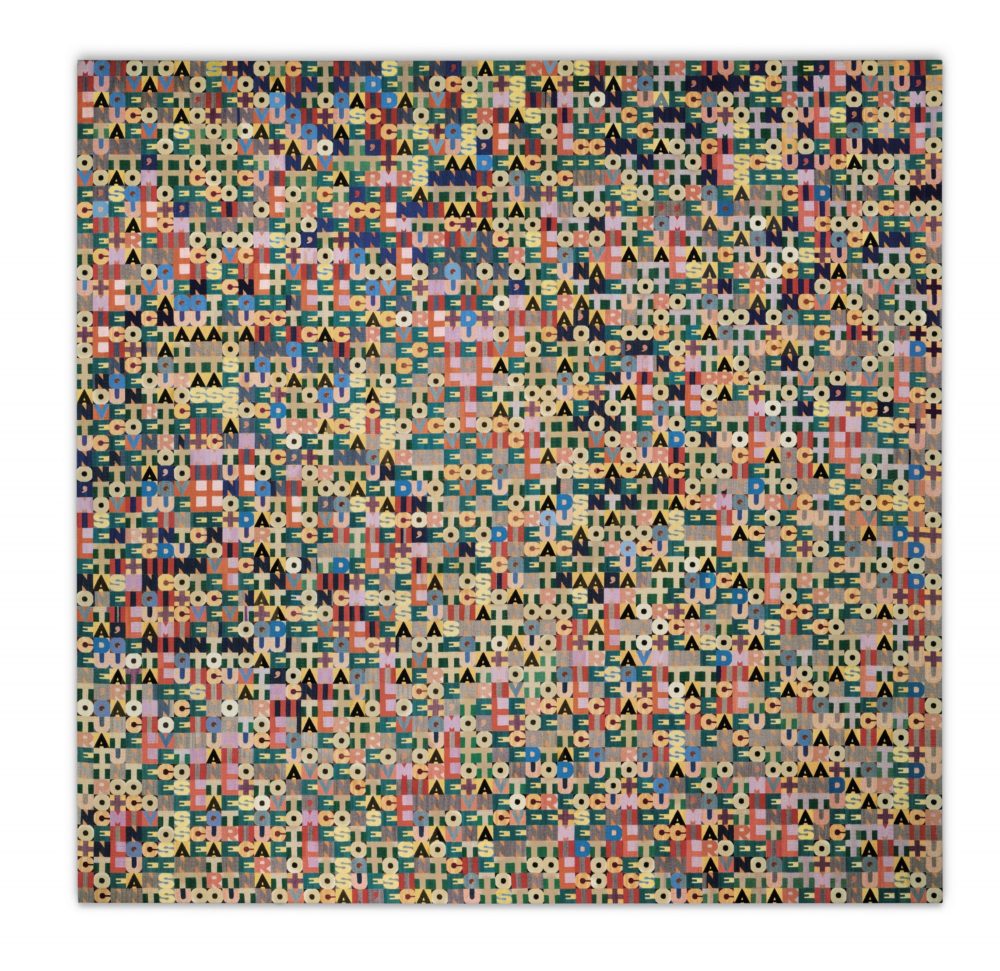
After four years of growth which saw sales increase from £32 million in 2011 to £83.6 million in 2015, London’s annual Italian art sales at Sotheby’s and Christie’s fell back to £42 million last October.
This year, Sotheby’s attempted to inject some variety into the formula—and some extra millions—by mixing Italian art with a few other related artists and movements: Zero artists Günther Uecker and Walter Leblanc; a Warhol Italian society portrait; Camargo—a Brazilian student of Lucio Fontana, and more, renaming the sale “Italian Art in Context.” The result was a 45-lot sale estimated at a modest £19.5/27.2 million without premium which realized £18.4 million ($24.2 million) with premium added, selling 31—or 69 percent—of the lots (prices include the buyer’s premium, estimates do not).
Top lot, and the only guaranteed lot in the Sotheby’s sale was Alighiero Boetti’s Addizione, a large tapestry teeming with letters. A smaller version had sold at Christie’s for £1.7 million in 2014 so Sotheby’s were confident offering this with the same estimate. It duly sold for £2.3 million ($3 million), a record for a Boetti tapestry, to a private collector bidding on the phone against London dealer Ben Brown in the room.
Michelangelo Pistoletto, Motociclisti, (1967).
Price realized: £1,508,750. Courtesy Sotheby’s
Other bidders in the room included the Nahmad family of dealers who pursued the best Fontanas, outbidding Brown on a white-and-brown slashed and punctured Concetto spaziale above estimate at £1.3 million ($1.71 million). Milan dealer Giulio Tega stepped up for a 1967 mirror painting by Michelangelo Pistoletto, Motorciclisti, at a mid-estimate £1.5 million, while Milan and London dealer, Nicolo Cardi bought Vincenzo Agnetti’s 1971 conceptual text work, Nudo, on the low estimate for £125,000 as well as Giulio Paolini’s erotic plaster work, Intervallo, at a bargain £200,000 against a £250,000 estimate.
Heralding his new post with the Lévy Gorvy gallery, Emilio Steinberger bought Enrico Castellani’s all-white shaped canvas Superficie Rigata above estimate for £848,750 for a US client, while Brown, the under-bidder of the evening, finally won out on an Yves Klein sponge at £518,750, with a bid just below the estimate.
Of the below-par performance of the sale overall, Claudia Dwek of Sotheby’s concurred that “it was a difficult sale to assemble.”
Lucio Fontana (1899-1968)
Concetto spaziale, In piazza San Marco di notte con Teresita
(1961). Price Realized: £10,021,250. Courtesy Christie’s
Christie’s had a smaller but better selection and sold a higher percentage (81 percent) of lots, but still barely scraped the £28.5 million low estimate with a £32.2 million ($42.3 million) sale including the premium.
Here the Nahmads were again in pursuit of Fontana but were outbid by a telephone bidder on the top lot, a luscious arrangement of colored glass stones on a velvety black background, Concetto spaziale in piazza San Marco in notte con Teresita, which had a third-party guarantee and sold within estimate for £10 million—the top lot of the series.
Brussels-based Paolo Vedovi was also after Fontana and was also outbid on a white canvas with eight slashes that sold to another phone bidder on the low estimate for £2.9 million.
Michelangelo Pistoletto (b. 1933), Man Looking at a Negative (1967)
Price Realized:£3,721,250. Courtesy Christie’s
There was disappointment when an Alberto Burri sack work from 1953 sold for a single bid on the low estimate, reaping £7.5 million, but that was compensated for by a new record for Michelangelo Pistoletto when his reflective stainless steel painting, Man Looking at a Negative, sold within estimate for £3.7 million, which is £1.4 million more than the previous record set three years ago.
Best mark-up of the sale was probably the £704,750 paid for Boetti’s large ballpoint-pen drawing which had cost the seller £49,350 in 2000.
Buyers making their mark in the salesroom were adviser Patricia Marshall, who bought Arte Povera artist Giovanni Anselmo’s two lumps of granite (Untitled) within estimate for £212,500; and dealers Nicolo Cardi, who bought another word piece, Portrait of a Lover, by Vincenzo Agnetti at a top estimate £150,000; Vedovi, who bought Pistoletto’s Ficus on the low estimate for £368,500; Giulio Tega, who bought a 1961 abstract, The Red Beneath, by Piero Dorazio for an above-estimate £236,750; and Marco Voena, who spent £525,000 on two Fontana ceramics.
Given that sales were down everywhere in 2016, the most meaningful comparisons are with the previous two years, and it comes as something of a shock to see that, even including the non-Italian art in the Sotheby’s sale, and Christie’s Italian art section in its day sale, the combined total of £52.8 million ($69.3 million), while close to the lower estimate and up on 2016, is still 58 percent down from 2015 when this rapidly expanding market seemed unstoppable.
Alighiero Boetti (1940-1994) The progressive disappearance of habit (1976-77)
ballpoint pen on paper. Price Realized: £704,750. Courtesy Christie’s
“I don’t think the steam has left the market. I just think it is back to normal!” commented Ben Brown afterwards. “If you have the right material at the right price you will definitely have buyers.”
“Of course the Sotheby’s sale was disappointing,” said Ursula Casamonti, a director of the Tornabuoni gallery. “But these auctions saw records for Pistoletto and for Alighiero Boetti’s biro works, as well as solid results for Fontana [the Venezia was a record for that particular series]. Judging an entire market on the basis of one unsuccessful auction is reductive and silly.”